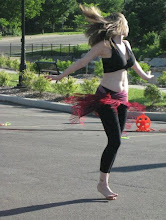



I had been writing a novel the other week at work when I had time to go through the second week of web 2.0 training. Unfortunately, I didn't have time to finish it though I would like to work on it some more and post it later. This section included a blog post with pictures.
I'd like to share some pictures of tribal bellydancers. One of my favorite dancers, Ariellah (photo one), once spoke in a video about how she loved to "be adorned." While movement creates the heart of a performance, tribal dancers are deeply concerned with the "aesthetics" of their dance, particularly in costuming. Tribal is a break away genre in which dancers shunned the typical "feminine" costuming and mannerisms for something more primal. More traditional costumes might include the typical bra/belt set, sequins, beads, bright colors and other flirty, sensual elements. Dancers like Rachel Brice (photo two) diverged from this trend, choosing instead to wear pants, along with more elaborate fringed belts, bras and headgear. (She is a major trendsetter in the bellydance world). Tribal girls are also more likely to display tattoos and piercings as part of their costuming.
Matrons of the dance in the US, women like Jamila Salimpour (photo three) and Caroleena Nericcio (photo four) explored combining existing and imagined folkloric elements into their ensembles. The typical American Tribal Style costume would include a full tribal skirt, belt with an overskirt, choli top or coin bra with a Turkish vest, and headgear that might include headbands with accessories spraying out or turbans. Caroleena once mentioned that this type of uniform gave the dance an appearance of looking old when in fact it was the complete opposite.
I love both Middle Eastern and American versions of bellydance and have been trying to find a happy medium between the two with costuming. Since the dance itself is constantly evolving, I'm happy to find its costuming is as well. This allows a dancer a number of variations to try in order to find the best form of self-expression in her "aesthetics." This makes the process of self-adornment a much more spiritual and personal one.

No comments:
Post a Comment